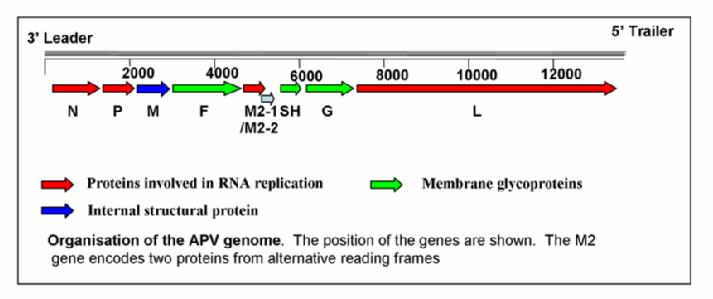Avian pneumovirus
Avian pneumovirus (APV)
Avian pneumovirus (APV) was first identified as the causative agent for rhinotracheitis in turkeys and swollen head syndrome in chicken in 1988 following its appearance in Europe. Since then the virus has become endemic in almost all countries in the world with the notable exceptions of Canada and Australia, and APV is now recognised as one of the major respiratory pathogens for domestic poultry throughout the world. Over recent years several reports have suggested that APV may also infect, and potentially be transmitted by, wild birds. APV isolates have been shown to fall into four distinct antigenic groups, A to D. Groups A and B were originally identified in Europe and group B isolates were isolated in the USA and certain restricted parts of Europe. The key determinants of antigenicity in APV are the major virus glycoproteins, the attachment (G) protein and to a lesser extent the fusion (F) protein. The economic importance of APV infection has stimulated many attempts to generate vaccines specific for APV with attention focused on the group A and B viruses. All vaccine candidates studied to date have been shown to be unsatisfactory due to instability with rapid reversion to pathogenicity or loss of protective immunity.
APV is a pneumovirus in the genus Metapneumovirus where the only other member is the relatively recently described human metapneumovirus (hMPV). These viruses are characterised by having a negative sense RNA molecule as genome which is transcribed into 8 mRNAs.

Over recent years the technique of reverse genetics for negative strand RNA viruses has permitted the analysis of the function of virus proteins and their role in pathogenicity. Reverse genetics of negative sense RNA viruses permits the precise mutation of a cDNA copy of the virus genome which is subsequently rescued into infectious virus to determine the biological consequence of the mutation. In this way it is possible to study the function of specific proteins during the replication cycle and their influence on pathogenicity. In addition, mutations may be introduced into the cDNA allowing insertion or deletion of genes and genetically stable multiple mutations such as deletions and insertions which can be used to generate vaccine candidates.
Working in collaboration with Dr Clive Naylor of the University of Liverpool, we have described an APV reverse genetics system for manipulating full length genomes. Using this system we are investigating the molecular basis of pathogenicity and the underlying characteristics required to generate protective immunity on vaccine candidates.
